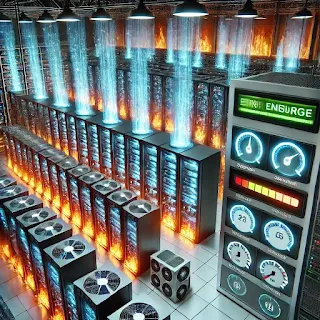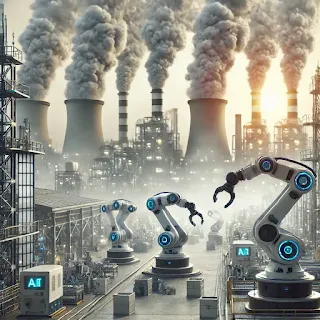AI and the Environment: The Hidden Costs and How We Can Fix Them
- Get link
- X
- Other Apps
AI and the Environment: The Hidden Costs and How We Can Fix Them
Introduction
Artificial Intelligence (AI) is changing the world, from revolutionizing healthcare to optimizing business operations. But while AI promises efficiency and progress, there’s a darker side that most people don’t see: its environmental impact.
AI models require massive computing power, which means huge energy consumption, increased carbon emissions, and growing electronic waste. In this article, we’ll explore how AI negatively affects the environment, provide real-world data, and suggest solutions to reduce its footprint.
 |
| A high-tech AI data center with massive energy consumption |
1. The Environmental Cost of AI: What Most People Don’t Know
1.1 AI’s Growing Energy Demand
Training large AI models—like ChatGPT, Google Gemini, or OpenAI’s DALL·E—requires thousands of powerful GPUs running for weeks or even months. This consumes more energy than some small countries.
🔹 A study from MIT found that training a single AI model can emit as much CO₂ as five gasoline-powered cars over their lifetimes!
🔹 In 2024, the International Energy Agency (IEA) estimated that AI data centers consume 1% of the world’s total electricity—a number expected to double by 2030.
1.2 AI Data Centers: The Silent Polluters
Big tech companies, including Google, Microsoft, and Amazon, operate thousands of data centers to support AI-powered services. These massive server farms require constant cooling, consuming enormous amounts of water and electricity.
🔸 A single Google data center uses 4–5 million gallons of water per day for cooling—comparable to a small town!
 |
| Graph showing AI's increasing energy consumption over the years |
1.3 The Hidden Cost of AI Hardware
AI isn’t just about software—it needs powerful hardware. From GPUs to specialized AI chips, manufacturing these components has a huge carbon footprint.
🔹 Rare Earth Metals: AI chips require rare-earth materials like lithium and cobalt, leading to harmful mining practices, deforestation, and pollution.
🔹 E-Waste Crisis: AI hardware has a short lifespan, contributing to the 50 million metric tons of electronic waste produced each year globally.
2. How AI Contributes to Climate Change
2.1 AI-Powered Industries and Carbon Emissions
AI is increasingly used in energy-intensive industries:
✔ Cryptocurrency Mining – AI enhances crypto algorithms, driving energy consumption.
✔ Autonomous Vehicles – AI-powered self-driving cars require continuous processing, increasing energy demand.
✔ Big Data & Cloud Computing – Every AI query runs through massive cloud networks, contributing to emissions.
🔹 According to a report by Nature (2024), the AI sector could contribute up to 3.5% of global CO₂ emissions by 2035 if sustainability efforts are not implemented.
2.2 AI’s Water Footprint
Water isn’t usually the first thing that comes to mind when discussing AI, but cooling data centers consumes billions of gallons annually.
🔹 Case Study: Google’s AI facility in Oregon consumed 1.2 billion gallons of water in just one year!
3. Can AI Be More Sustainable? (Yes, But Here’s How)
3.1 Green AI: The Next Big Innovation
To reduce AI’s environmental impact, researchers are working on Green AI—a movement focused on making AI models smaller, faster, and more energy-efficient.
🔹 New AI Algorithms: Companies like Meta and OpenAI are designing models that require less computing power while maintaining accuracy.
🔹 Efficient Data Centers: Tech giants are investing in liquid cooling and AI-powered energy optimization to cut emissions.
3.2 Renewable Energy-Powered AI
The best way to reduce AI’s footprint? Power it with solar, wind, and hydro energy.
🔹 Microsoft’s AI Division now runs on 100% renewable energy, setting an example for the industry.
4. What Can Businesses and Individuals Do?
4.1 For Companies:
✅ Use Renewable Energy – Shift AI operations to green energy sources.
✅ Invest in Energy-Efficient AI – Use optimized models that consume less power.
✅ Recycle AI Hardware – Develop responsible e-waste recycling programs.
4.2 For Individuals:
✅ Choose Sustainable AI Services – Support companies committed to green AI.
✅ Reduce Cloud Storage Usage – Every gigabyte stored online consumes energy.
✅ Spread Awareness – Educate others about AI’s environmental impact.
 |
| A researcher developing sustainable AI technology in a green lab |
5. Conclusion: The Future of AI and Sustainability
AI is shaping the future, but it comes at an environmental cost. While AI is not inherently bad, its energy consumption, carbon footprint, and resource use must be addressed.
The good news? Green AI, renewable energy, and sustainable computing are making AI more eco-friendly. But it requires action from tech companies, governments, and individuals alike.
🌍 The question isn’t whether AI will be part of our future—it’s whether it will be sustainable. The choice is ours!
📚 Sources
1️⃣ MIT Technology Review (2024) – AI’s Energy Demands and Carbon Footprint
2️⃣ International Energy Agency (IEA) – AI Data Centers & Global Energy Use
3️⃣ Nature Journal (2024) – The Climate Impact of AI Models
4️⃣ Microsoft AI Sustainability Report – Green AI & Renewable Energy Integration
- Get link
- X
- Other Apps



Comments
Post a Comment